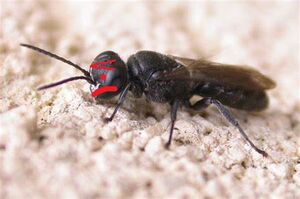Binomial nomenclature
| Binomial nomenclature | |
|---|---|
Depiction of a colony of B. nomenclatura in their natural habitat. Binomens are concepts, but they can use Neo-Latin words as their meta-embodiments. | |
| Scientific classification | |
| Kingdom | Scientia |
| Phylum | Biologia |
| Class | Dogma |
| Order | Binominales |
| Family | Binominaceae |
| Genus | Binominis |
| Species | B. nomenclatura |
| Binomial name | |
| Binominis nomenclatura | |
“I'll name this lovely flower after horse udders!”
– Carl Linnaeus
Binominis nomenclatura is one of the two extant species of the genus Binominis, the other one being B. distributio. Commonly known as binomial nomenclature or binomen in the general population, it is a prolific and widespread organism that colonizes many information media.
Etymology[edit | edit source]
From Latin. The generic name binominis, "of two names", is the genitive of binomen, itself bis + nōmen. The specific epithet nomenclatura comes from corrupted Japanese namae that had gone around the Arabian peninsula then formed with clatur according to Greek agglutination rules.
Evolution[edit | edit source]
Antiquity[edit | edit source]
The origin of binomens are unclear. Not only have many etymons lost to time, but binomens' noun-descriptor system was also believed to have been petted by the Ancient Gods. As abstract concepts, binomens manifested through the signs of life, roaming the Earth through mycelium, across flower buds, and bound on wings. Their oracles carried vertically through time, as spirits beyond any worldly language.
Originally, B. nomenclatura individuals possessed magical qualities; for example, because they each capture the collective essence of an organism in a mere concept, their polysynthetic complexity carried heavy information density, enough to lag the world around them and thus manipulate time.
Early modern era[edit | edit source]
In 1735, Carl Linnaeus published Systema Naturae, materializing the intangible spirits of binomens and building the foundation of modern taxonomy by counting the number of sexual organs of plants.
At that time, binomen magic reached its prime. Learned scholars could summon them with curly fonts on paper, and with the Latinisque spells they unleashed borderless power to shred their opponents with science. Like, you know, the time when Linnaeus named several most noxious weeds after his rivals.
Industrial revolution[edit | edit source]
With the advent of early modern technology, the magical qualities of binomens plummeted. Authors and casters immediately assumed that the culprit was the incompatibility of machine holes and natural penises; on the other hand, a review article pinpointed "genial dissonance" as the cause. As a result, opposing scholars interchanged magic attacks with each other, prompting an era of pompous, deceitful, and antimetrical binomen names. The upheaval only died down following the retraction of the "genial" article due to the fatal spelling mistake.
However, the decline of magic was due to dilution, as more people had access to education and wanted their own share of binomen magic. The actions of the academia had only worsened the situation, as the scholarly internal conflict had generated public attention, even promoted by the YouTube algorithm, causing a greater influx of novice magicians.
Modernity[edit | edit source]
The downfall of binomen magic was going down a slippery slope. The glowing new binomens have caused magic to fade, as 20th-century organism names mainly focused on shock factor and attention-grabbing ability, so as to be recommended by YouTube. In this destruction of traditional culture, the public also did well, proceeding to learn and distort more binomens, turning them into Homo sapien, Biggus dickus, etc.
In the post-World War II era, binomens saw new bastard contenders rising from the big screen: human subspecies. By creating new humans classified as Homo consumericus, Homo stultus, and Femina feminismi, writers have edged out the native binomen names out of public sight. Toward the end of 20th century, cases of human-binomen romance became more common, often with unorthodox or sensationalized binomens. In the 21st century, commercialization has given rise to a genre of new binomen names, such as Scaptia beyonceae and Dermophis donaldtrumpi. With the massive popularity of these celebrity endorsers, binomens have been degraded to regular commodities, and the coffin was stapled shut for the ancient art of binomen magic.
Epigenetics[edit | edit source]
There have been much scholarly investigation into the apparent differences among binomens applied to animals, plants and fungi. The most common explanation is based on the schism and arms-race between ICZN and ICNafp.
According to this theory, the gene SBSP68 encodes the enzyme L-subspeciesyltransferase, which catalyzes the formation of the qualifier subsp. However, in B. n. zoologiae, this gene has undergone mutations that made it malfunctional. At the same time, the naming organizations for animals and plants were separated, blocking horizontal gene transfer and retaining the variations seen today.
However, reviews cautioned against similar analysis of binomens in bacteria nomenclature due to its instability. The names of many bacteria, even industrially important ones, are in constant flux, as the ICSP declared their nomenclature to be a kind of "interactive art". The genus Lactobacillus switches to the name Holzapfelia during daylight saving time, and probably something else on Halloween.
Language[edit | edit source]
Binomens have been speaking their own language since the early days of Earth. In prehistoric times, their language was poetic and elegant, especially when making pies. After its anthropogenic downfall, the binomen language is regarded as an anachronism stew of a multilingual pidgin, complete with a wide variety of dialects. Through conflicts and reforms, the language ascended beyond other natural languages and got rid of auxiliary verbs and pronouns altogether, while still preserving the friendly, cordial spirits of the old.
Oh, and they also lost the ability to smite their enemies with diacritical hits. Sad lifeforms.




